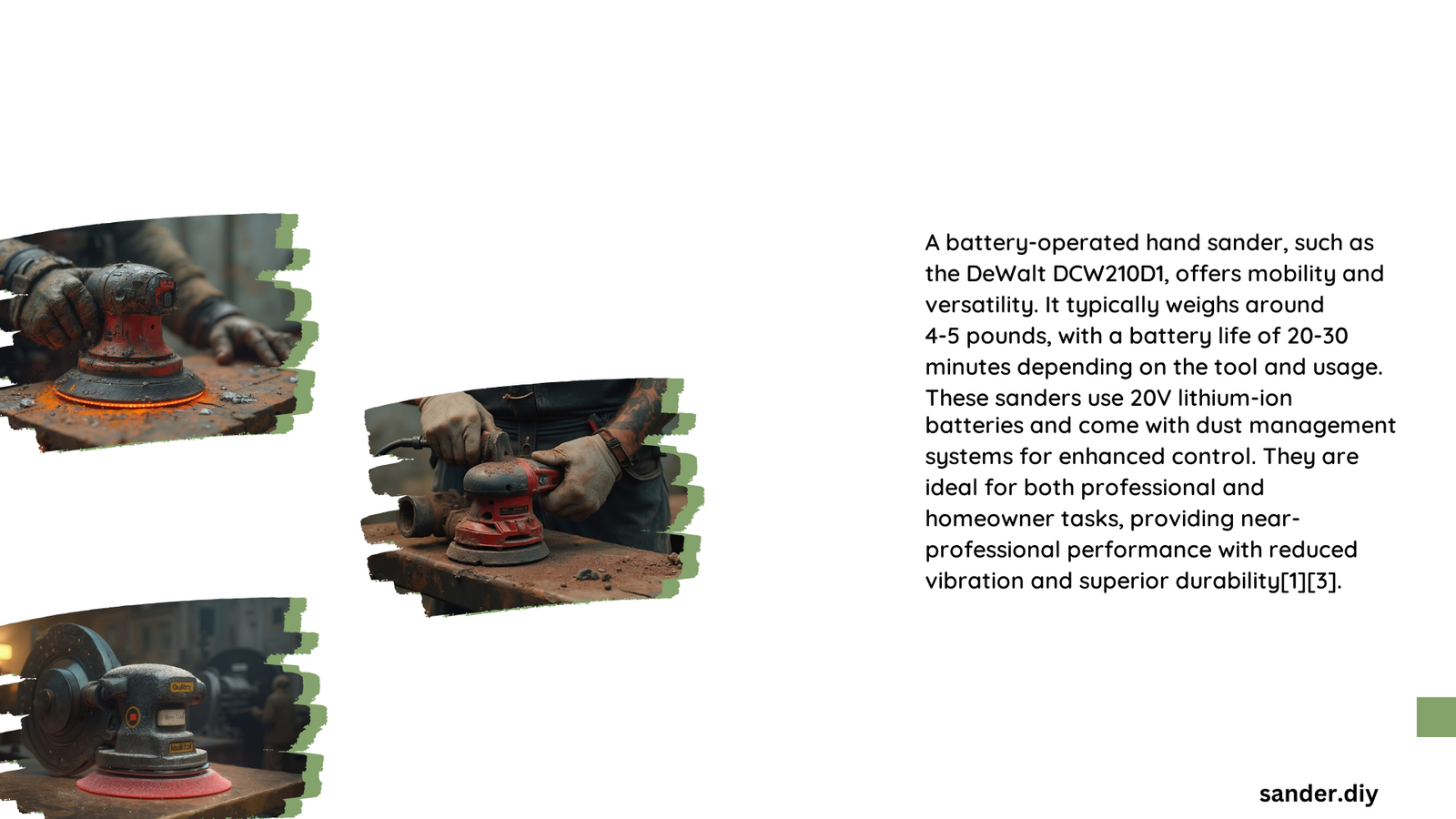Battery-operated hand sanders have revolutionized the woodworking and DIY industries by offering cordless convenience without sacrificing power. These portable tools provide the freedom to sand in any location, making them ideal for both professionals and hobbyists. With various models available from top brands like Black & Decker, DeWalt, and Milwaukee, users can choose from a range of features including variable speeds, efficient dust collection systems, and compatibility with high-capacity batteries.
What Are the Key Features of Battery-Operated Hand Sanders?
Battery-operated hand sanders come with a variety of features designed to enhance performance and user experience:
- Cordless Design: Allows for unrestricted movement and use in remote locations
- Variable Speed Control: Enables precise sanding for different materials and finishes
- Dust Collection Systems: Integrated canisters or vacuum attachments for cleaner work environments
- Brushless Motors: Offer increased efficiency and longer runtime
- Ergonomic Grips: Provide comfort during extended use
Let’s take a closer look at some popular models:
Black & Decker 20V MAX* Random Orbital Cordless Sander
- Voltage: 20V MAX* (nominal voltage: 18V)
- Battery Capacity: 1.5 Ah
- Weight: 3.6 LB
- Speed: 12,000 orbits per minute (OPM)
- Dust Collection: On-board dust collection canister
DeWalt 20V MAX* XR 5 in Brushless Cordless Variable-Speed Random Orbital Sander
- Voltage: 20V MAX*
- Speed: Variable speed from 8,000 to 12,000 OPM
- Weight: 30.4 oz (0.9 kg)
- Dust Collection: One-handed locking dust bag and compatible with DWV010 or DWV012 dust collectors
Milwaukee M18™ Random Orbit Sander
- Voltage: 18V (M18 system)
- Runtime: Up to 35 minutes on a M18™ 3.0Ah Battery Pack
- Weight: 2 lbs
- Speed: Variable speed from 7,000 to 12,000 OPM
- Dust Collection: Dust canister with filter and universal hose adapter
How Do Battery-Operated Hand Sanders Compare to Corded Models?

When comparing battery-operated hand sanders to their corded counterparts, several factors come into play:
| Feature | Battery-Operated | Corded |
|---|---|---|
| Portability | High | Limited by cord length |
| Power Consistency | May decrease with battery drain | Consistent |
| Runtime | Limited by battery capacity | Unlimited |
| Maintenance | Battery care required | Minimal |
| Initial Cost | Generally higher | Generally lower |
While corded sanders offer unlimited runtime and consistent power, battery-operated models provide unmatched portability and convenience, especially for jobs in remote locations or areas without easy access to power outlets.
What Are the Advantages of Using a Battery-Operated Hand Sander?
- Increased Mobility: Work anywhere without the need for power outlets
- Improved Safety: No risk of tripping over cords
- Versatility: Ideal for both indoor and outdoor projects
- Reduced Fatigue: No cord drag during operation
- Compatibility: Often part of a larger cordless tool ecosystem
What Challenges Might Users Face with Battery-Operated Hand Sanders?
Despite their many benefits, battery-operated hand sanders do come with some challenges:
- Limited Runtime: Depending on the battery capacity and work intensity
- Charging Downtime: Need to pause work for battery recharging
- Battery Maintenance: Proper care required for optimal performance and longevity
- Higher Initial Cost: Generally more expensive than corded models
- Power Consistency: Potential for reduced power as battery drains
How Can Users Maximize Efficiency with Battery-Operated Hand Sanders?
To get the most out of your battery-operated hand sander, consider these tips:
- Use High-Capacity Batteries: Opt for batteries with higher Ah ratings for extended runtime
- Keep Multiple Batteries: Have spare charged batteries ready to swap
- Invest in Fast Chargers: Minimize downtime with rapid charging options
- Maintain Your Tool: Regular cleaning and proper storage extend tool life
- Choose the Right Sandpaper: Match grit to your project for efficient material removal
What Types of Sanding Pads Are Compatible with Battery-Operated Hand Sanders?
Most battery-operated hand sanders use standard 5-inch sanding discs, available in various grits:
- Coarse Grit (40-60): For heavy material removal
- Medium Grit (80-120): For general smoothing and preparation
- Fine Grit (150-180): For finishing and between-coat sanding
- Ultra-Fine Grit (220+): For final finishing and polishing
Sanding pad costs typically range from $5 to $20 for a pack, depending on quality and quantity.
How Does the Cost of Ownership Compare for Battery-Operated Hand Sanders?
When considering the total cost of ownership for a battery-operated hand sander, factor in:
- Initial Purchase Price: Generally higher than corded models
- Battery Costs: Additional or replacement batteries
- Charger: Fast chargers may be an extra expense
- Sanding Pads: Ongoing consumable cost
- Maintenance: Potential battery replacement over time
While the upfront cost may be higher, the versatility and convenience of battery-operated sanders can offset this for many users, especially those who value portability in their work.
By understanding the features, benefits, and challenges of battery-operated hand sanders, users can make informed decisions about whether these tools are right for their needs. With proper care and use, a battery-operated hand sander can be a valuable addition to any toolkit, offering the perfect blend of power and portability for a wide range of sanding tasks.
References:
1. https://www.blackanddecker.com/products/bdcro20c
2. https://www.dewalt.com/product/dcw210b/20v-max-xr-5-brushless-cordless-variable-speed-random-orbital-sander-tool-only
3. https://www.milwaukeetool.com/Products/2648-20
